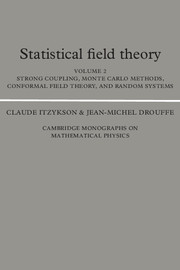10 - Disordered systems and fermionic methods
Published online by Cambridge University Press: 05 August 2012
Summary
Real systems may involve various types of defects. It is therefore important to assess their relevance and to estimate their effect on the results established in pure cases. The emphasis here is on stability and robustness versus random perturbations. We present in the last section of this chapter the Harris criterion for estimating the effect of weak disorder on a critical system. At a more fundamental level, one can also look for new phenomena originating in the very existence of defects. For instance, the dynamics of dislocations in a crystal can explain the solid-liquid transition. Similarly, we were led to analyze the role of vortices when studying the XY-model. Random impurity potentials produce the localization of quantum wavefunctions (Anderson, 1958), which enables one to understand the transition between insulators and conductors. This same localization phenomenon appears in other contexts involving classical waves, such as optics or sound propagation. This subject has given rise to an intense activity. One cannot claim that it is fully understood at present, eventhough the weak disordered case seems under control, thanks to renormalization group arguments. The role of magnetic fields has opened a new area of research centered on the quantum Hall effect. Another domain which has stimulated vigorous and original developments is the one of magnetic systems with random and/or phase, where magnetic moments can become frozen in random directions, with a plethora of metastable states, or valleys, in free energy.
- Type
- Chapter
- Information
- Statistical Field Theory , pp. 646 - 737Publisher: Cambridge University PressPrint publication year: 1989



